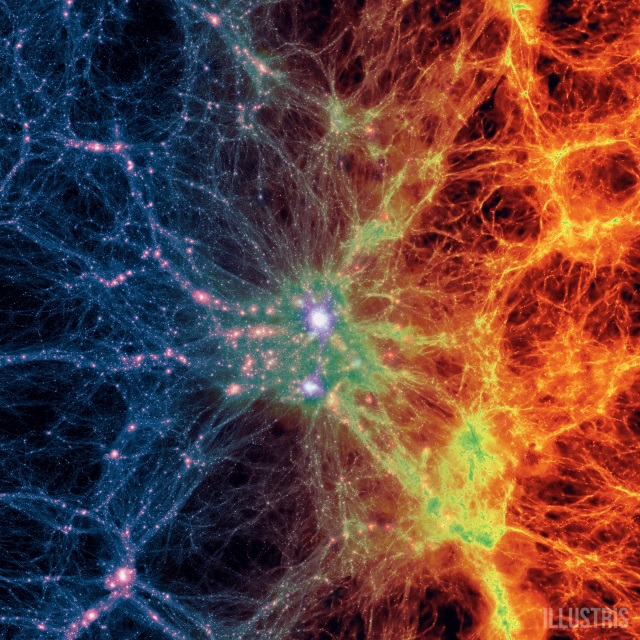
by Lizzie Reinthal Thursday, September 25, 2014

Illustris simulation of dark matter transitioning to gas density. Credit: Illustris Simulation.
The universe burst into existence 14.6 billion years ago, and has been expanding ever since. Of course, humans have only been around to glimpse the most recent fraction of stellar history. Now, a new high-powered computer simulation called Illustris, which traces more than 13 billion years of cosmological evolution, is giving scientists and the public alike an armchair view of how things came to look the way they do.
Beginning 300,000 years after the Big Bang, Illustris reproduces galaxy formation, composition and distribution over time — correctly capturing galactic properties like morphology, size and luminosity — and “is the most accurate virtual representation of the cosmos to date,” says Mark Vogelsberger, an astrophysicist at MIT, who was the lead author of a recent study in Nature describing the simulation. The model predicts gas and metal contents in the universe, mimicking observed conditions, according to Vogelsberger and his colleagues. It also recreates predicted effects of visible matter particles called baryons on dark matter, which may help refine future studies of the mysterious interstellar substance thought to comprise 27 percent of the universe.
Thanks to the huge volume of information input into the model, as well as high-resolution imagery, the galaxies in the computer-generated universe compare well to photographs of the real universe made by the Hubble Space Telescope, becoming the first hydrodynamic simulation to do so. Hydrodynamic simulations are computational methods used in theoretical astrophysics to reconstruct the fluid dynamics of gases based on algorithms. (See a cool video of the process here.)
Utilizing more than 8,000 computer cores working concurrently with supercomputers in the U.S., Germany and France, the simulation took 19 million CPU hours and three months to complete. For perspective, a single desktop computer would have completed the same job in 2,000 years.
The simulation is important for two main reasons, Vogelsberger says. First, it provides a huge dataset — covering a large simulated portion of the universe containing many thousands of galaxies — that can be analyzed in many different ways, and that can potentially enhance scientific understanding of how galaxies form. Such knowledge may improve our understanding of how the universe evolved into its current state, according to Vogelsberger and his colleagues.
Second, it demonstrates that a realistic galaxy can form in a simulated universe made mostly of dark matter and dark energy, as the real universe is believed to be, once proper modeling of the relevant physical processes is used.
“This strengthens our confidence in this standard cosmological model, which has previously not been shown to be able to reproduce the observed properties of galaxies,” says Shy Genel, an Institute for Theory and Computation post-doctoral fellow at Harvard University’s Center for Astrophysics and a co-author on the new study.
Although Illustris shows much promise for advancing our understanding of the universe, it does have limitations. For example, “the study is limited by our inability to track the small-scale evolution of gas and stars to the present epoch,” Vogelsberger says. Another problem with the model, he says, lies in the formation of low-mass galaxies: The simulation creates too many of these galaxies too early in time, resulting in star systems that are older than those currently known in the universe.
But these issues, which affect the model’s ability to recreate changes over relatively short timescales and when creating small galaxies, are relatively minor compared to Illustris’ overall usefulness, Genel says. “Illustris is like a time machine. We can go forward and backward in time. We can pause the simulation and zoom into a single galaxy or galaxy cluster to see what’s really going on,” he says. The model, over time, will continue to get better at mimicking what we see astronomically, he says.
© 2008-2021. All rights reserved. Any copying, redistribution or retransmission of any of the contents of this service without the expressed written permission of the American Geosciences Institute is expressly prohibited. Click here for all copyright requests.